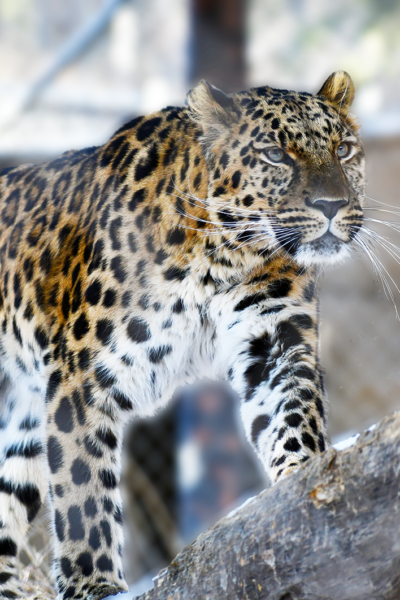If you’ve visited Asian Highlands at CMZoo lately, you’ve probably noticed a lot of activity around the south leopard habitat. Our keepers, grounds and maintenance crews, and Zoo architect, have been working together to upgrade the leopards’ home, thanks to generous support from a friend of the Zoo.

The cross-departmental CMZoo design team brought different kinds of expertise to the table, each presenting goals and offering solutions to each other’s challenges. The first thing guests will likely notice is how much more of the exhibit they can see. The glass is gone, which means our guests can see the leopards better without a glare, and the huge log-and-steel crossbeam required for the glass-front structure could also be removed. Without that necessary structure, guests will have a much better view of a lounging leopard high in the trees. The leopards’ new perching is closer to the mesh, too, so the cats have a great view overlooking the Zoo. With as few barriers as is safely possible, guests can feel closer to them, which fosters the connections we believe inspire people to support conservation.
“Our goal was to make their home more enriching for the leopards, and more immersive for our guests,” said Basia Dann, Asian Highlands keeper. “They have tons of new perching, an upgraded waterfall, and mesh at the viewing area, instead of glass. So far, guests seem super excited about the glass being gone, and leopards are taking advantage of new opportunities in that habitat.”
Three leopards will use the habitat: Bhutan, a 13-year-old male snow leopard; Anya, an 8-year-old female Amur leopard; and Anadyr, a 6-year-old male Amur leopard. The Amur leopards will sometimes share the space together, and sometimes they’ll explore it alone. When they’re not in the newly remodeled leopard exhibit, they’re exploring other yards, including the guest-facing north leopard yard, just above Australia Walkabout.
Bhutan prefers the solitary life, so he’ll enjoy the new digs by himself. Based on Bhutan’s reaction to his first time in the new setup, he approves.
“Bhutan likes to lay in flatter, cooler spots, so we added some shady soil patches for him by the waterfall,” said Dann. “The first time he came into the exhibit, he spotted one of those patches and immediately went to lie down in it. It’s rewarding to see that our team’s hard work combined with our intimate knowledge of these cats is going to benefit them on a daily basis.”
Most CMZoo visitors are aware of the enrichment activities and training sessions keepers provide to keep our animals mentally and physically fulfilled. But, did you know the habitats themselves are designed to enrich our animals, and to encourage their natural behaviors?
For example, Rocky Mountain goats need vertical opportunities to climb, so their habitat reflects that. Hippos need a combination of water at various depths, and flat land to graze. Orangutans need objects to swing between. Leopards are expert tree climbers, so guests will notice ten new tree perches for them to navigate. They also like to rest up high in the trees, because it gives them a better vantage point. They’re often seen sleeping on their tummies with legs on either side of a large branch, and they have many opportunities for that in their new habitat.

“Our horticulture and grounds teams made the new perching adjustable, which is amazing,” said Dann. “If we find that our perching is too steep, or not steep enough, we can adjust a few bolts and see if the cats prefer things at a different angle. It means we’re not ‘stuck’ with the design, if we find our leopards aren’t engaging with it.”
The team also wanted to upgrade the habitat’s water feature. A previously unused waterfall has been revamped to help keep the leopards cool and provide an immersive, natural sound for guests.
“We want our guests to feel like they’re in the Far East or near a snowmelt stream in the Himalayas, where these big cats roam,” said Dann. “We thought we could do that with the waterfall, but we knew our leopards don’t like to be splashed. That was one of many examples of our teams coming together to find a solution that met all of our needs. Our keepers worked closely with our architect, horticulture, grounds and maintenance teams to get the flow of waterfall just perfect.”
The team also added some big rocks to the center of the pond, and set a low water level, so the leopards have cool rocks to nap on and they can wade into the shallow pond, if they choose to.
All three leopards have explored the new space, and Asian Highland keepers have been happy with their engagement.
“As keepers, we love the relationships we get to build with the animals, but we don’t want their lives to revolve around us,” said Dann. “We work to give them the comfort they seek from a habitat, but also problems to solve as independent beings. I love that we can provide these environments that give them more choices in their daily lives.”
There are a few final touches in the works, including a permanent waist-high fence to replace the temporary barrier that keeps guests at safe distance from the big cats’ mesh fencing. Guests can visit the leopards in Asian Highlands now.

